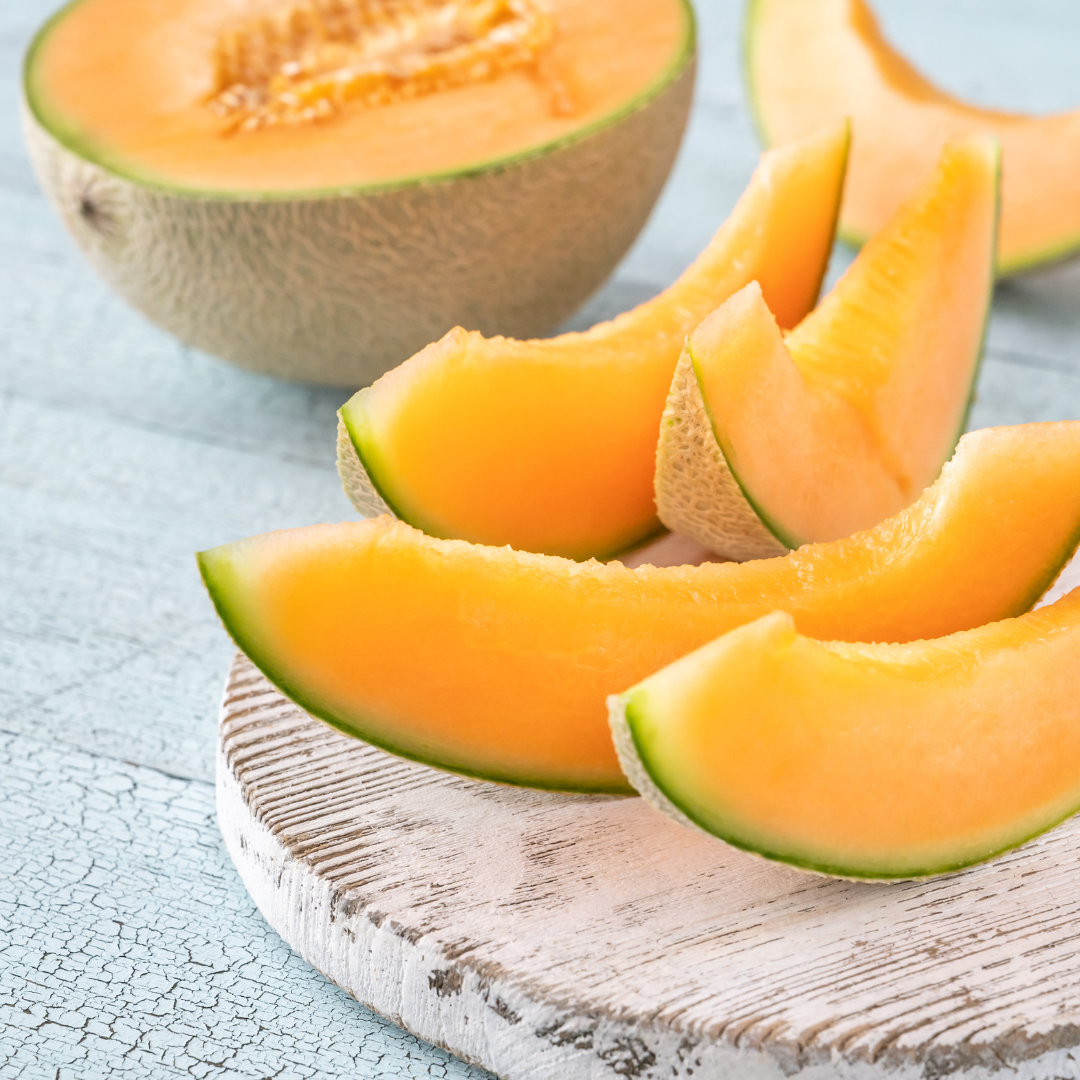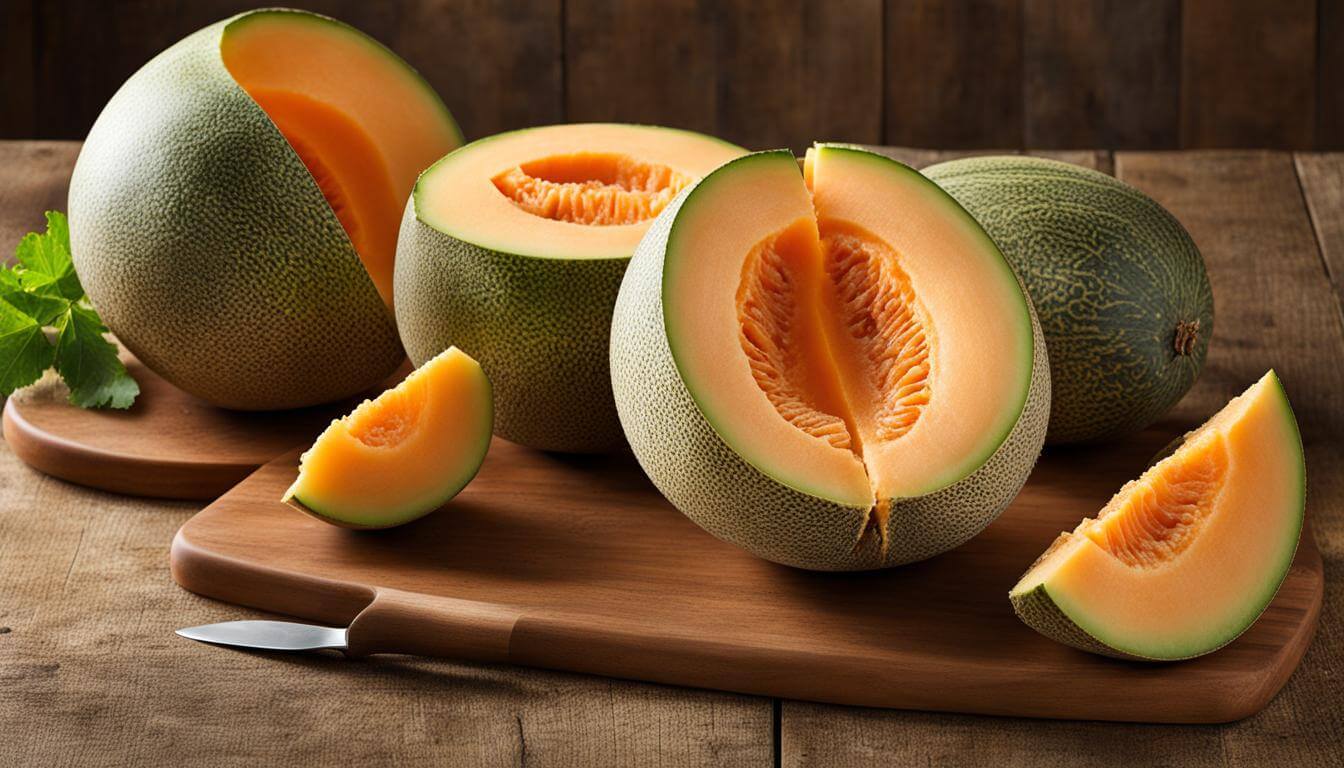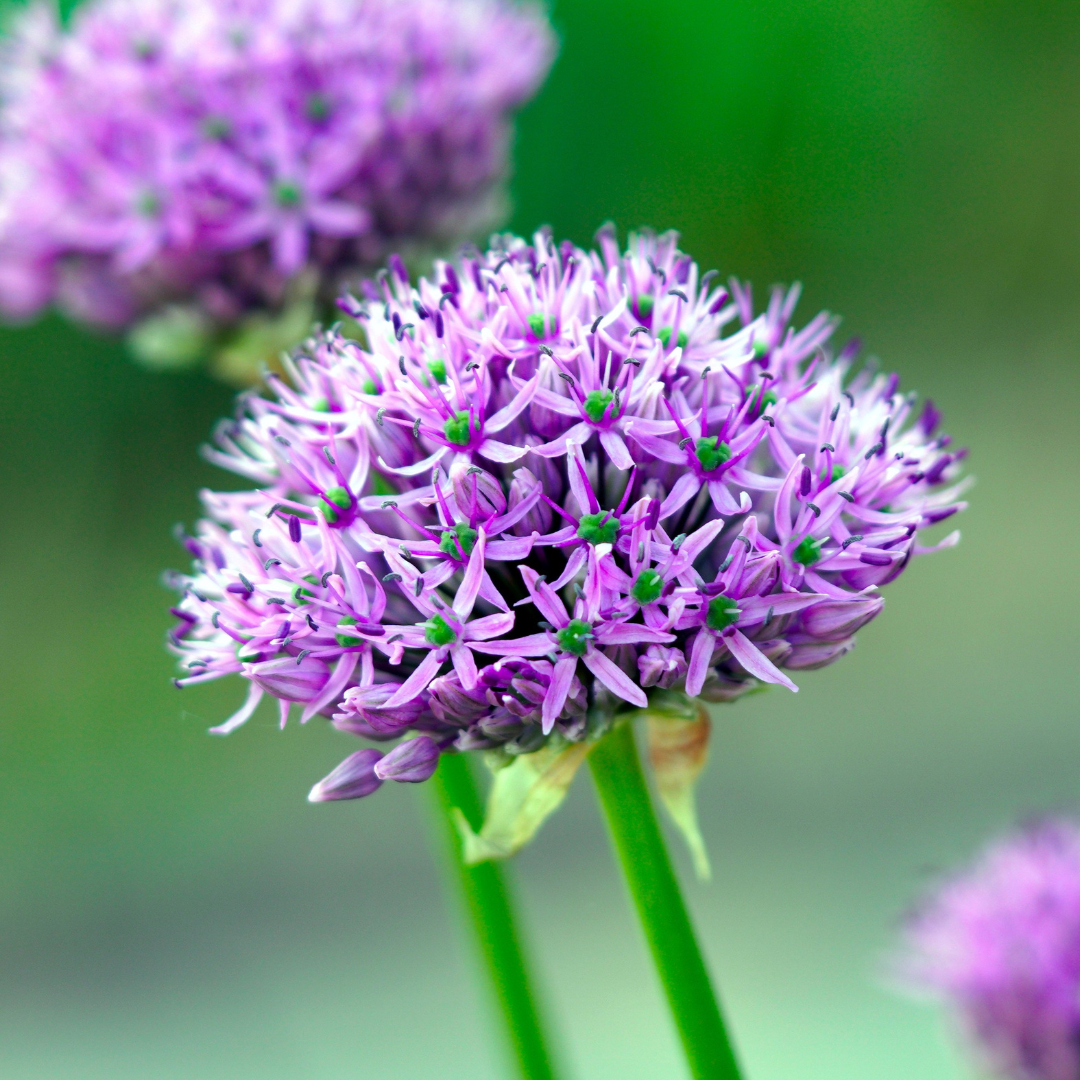Cantaloupe is a delicious and nutritious fruit that is relatively easy to grow from seed. Whether you're a seasoned gardener or a novice, with a little patience and effort, you can enjoy the sweet, juicy flavor of homegrown cantaloupes. In this article, we will discuss the step-by-step process of how to grow cantaloupe from seed, from choosing the right cantaloupe varieties to dealing with pests and diseases.
Hales Best Jumbo Cantaloupe Seeds
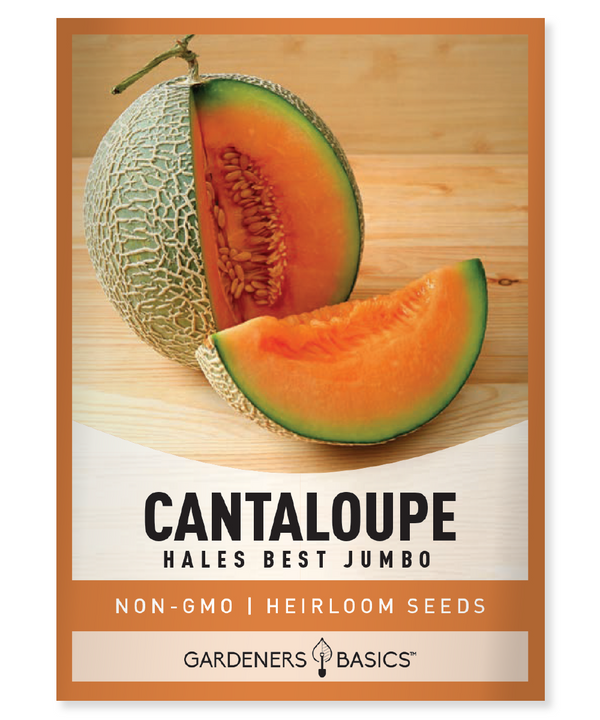
$2.49
Hales Best Jumbo Cantaloupe Seeds - Heirloom, Non-GMO, Non-Hybrid, Open-Pollinated Grow the sweetest and most aromatic cantaloupes with Hales Best Jumbo Cantaloupe Seeds, a classic heirloom variety cherished by gardeners for its exceptional flavor, vigorous growth, and high yields. These… read more
Choosing the Right Cantaloupe Varieties
Before sowing your cantaloupe seeds, it's essential to choose the right cantaloupe variety for your growing conditions. Here are some popular cantaloupe varieties you can choose from:
- Hale's Best Jumbo: A widely grown variety that produces sweet, juicy, and aromatic cantaloupes with firm flesh.
- Athena: A disease-resistant cantaloupe variety that produces sweet, juicy, and flavorful fruit with a smooth texture.
- Sarah's Choice: A popular variety that produces small to medium-sized, sweet, and aromatic cantaloupes with deep orange flesh.
Starting Cantaloupe Seeds Indoors
Cantaloupe seeds need warm soil to germinate, so it's best to start them indoors, about four to six weeks before the last expected frost date in your area. Here are the steps to start cantaloupe seeds indoors:
- Fill a seed-starting tray with a seed-starting mix, and water it thoroughly.
- Plant two to three cantaloupe seeds per cell, about 1/2 inch deep, and cover them with soil.
- Place the tray in a warm, sunny location, or under a grow light.
- Keep the soil moist but not waterlogged, and provide good air circulation.
Assorted Melon Seeds | 5 Variety Pack
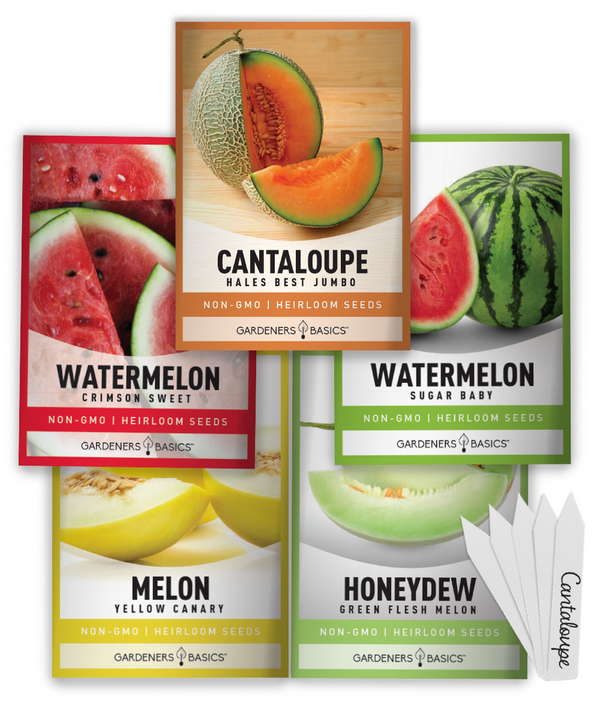
$9.95
Grow Fresh Summer Melons with Our 5-Pack Heirloom Melon Seeds Assortment Are you looking to add some variety to your home garden? Our melon fruit seeds 5 variety pack includes a mix of delicious and nutritious melon seeds that are… read more
Preparing the Soil
Cantaloupe plants prefer well-draining soil with a pH of 6.0 to 6.8. Before planting, prepare the soil by doing the following:
- Remove weeds, rocks, and debris from the planting area.
- Loosen the soil to a depth of 12 inches.
- Incorporate organic matter such as compost or aged manure into the soil.
Transplanting Cantaloupe Seedlings
When the danger of frost has passed, and the soil temperature is at least 60 degrees Fahrenheit, you can transplant your cantaloupe seedlings outdoors. Here's how to do it:
- Choose a sunny location with good air circulation.
- Dig a hole for each seedling, about twice the size of its root ball.
- Carefully remove the seedling from the cell, taking care not to damage the roots.
- Place the seedling in the hole, and fill the hole with soil.
- Water the plant well.
Choosing the Best Location for Cantaloupe
Cantaloupe plants need plenty of sunshine, warm temperatures, and good air circulation to thrive. Choose a location that receives at least 6 to 8 hours of direct sunlight per day, and avoid planting your cantaloupe in low-lying areas where cold air can settle. Good air circulation can help prevent fungal diseases, so consider planting your cantaloupe in a location where there is a breeze or in an area with good ventilation.
Checking Soil Temperature
Cantaloupe seeds need a soil temperature of at least 60 degrees Fahrenheit to germinate, so it's important to check your soil temperature before planting. Use a soil thermometer to check the temperature at a depth of 2 to 3 inches. If the soil temperature is too low, consider using black plastic mulch to warm the soil or using row covers to protect young plants from cold temperatures.
Providing Water and Fertilizer
Cantaloupe plants need about an inch of water per week. Water deeply and infrequently, rather than shallowly and frequently, to encourage deep root growth. Here are some tips for watering cantaloupe plants:
- Water early in the morning to prevent fungal diseases.
- Avoid getting water on the leaves, as this can promote powdery mildew.
- Mulch around the plants to help retain soil moisture.
Cantaloupe plants also benefit from regular fertilization. Apply a balanced fertilizer every three to four weeks, following the manufacturer's instructions.
Dealing with Pests and Diseases
Cantaloupe plants are susceptible to pests and diseases, including cucumber beetles, squash bugs, and powdery mildew. Here are some tips for dealing with these issues:
- Use row covers to protect young plants from insect damage.
- Apply insecticidal soap or neem oil to control cucumber beetles and squash bugs.
- Monitor your plants regularly for signs of powdery mildew, and remove affected leaves promptly.
- Improve air circulation by spacing your plants adequately and pruning the cantaloupe vines.
Encouraging Pollination
Cantaloupe plants have both male and female flowers, and bees play a crucial role in pollinating them. To encourage pollination and increase your chances of a bountiful harvest, do the following:
- Avoid using insecticides during the day when bees are active.
- Attract bees to your garden by planting other flowers that they like, such as sunflowers and zinnias.
- Identify the male flowers (which have a straight stem) and the female flowers (which have a bulbous base), and make sure that both types are present in your garden.
Giving Cantaloupe Plants a Head Start
Cantaloupe plants have a long growing season, and in some areas, the growing season may not be long enough to produce ripe fruit. To give your cantaloupe plants a head start, do the following:
- Start cantaloupe seeds indoors several weeks before the last frost date in your area.
- Use row covers or cloches to protect young plants from cold temperatures and frost.
- Choose early-maturing cantaloupe varieties that can produce ripe fruit in as little as 70 days.
Harvesting Cantaloupe
Cantaloupes are ready to harvest when they slip easily off the vine and have a sweet, fruity aroma. Here are some tips for harvesting cantaloupe:
- Check your plants daily once the fruit begins to ripen, as they can become overripe quickly.
- Use a sharp knife or pruner to cut the cantaloupe from the vine, leaving a short stem.
- Store the cantaloupes at room temperature for a few days to ripen further, or in the refrigerator to prolong their shelf life.
Dealing with Powdery Mildew
Powdery mildew is a common fungal disease that can affect cantaloupe plants. It appears as a white, powdery coating on the leaves, stems, and fruit of the plant. To prevent powdery mildew, avoid getting water on the leaves when watering your plants, and improve air circulation by pruning your cantaloupe vines and spacing your plants adequately. If you notice powdery mildew on your plants, remove affected leaves promptly, and consider applying a fungicide if necessary.
Assorted Melon Seeds | 5 Variety Pack

$9.95
Grow Fresh Summer Melons with Our 5-Pack Heirloom Melon Seeds Assortment Are you looking to add some variety to your home garden? Our melon fruit seeds 5 variety pack includes a mix of delicious and nutritious melon seeds that are… read more
Using Companion Planting
Companion planting is the practice of planting certain plants together to help repel pests, attract beneficial insects, or improve soil health. Some plants that are beneficial to plant near cantaloupe include:
- Marigolds: These flowers are known to repel cucumber beetles and squash bugs.
- Nasturtiums: These flowers are known to attract aphids away from your cantaloupe plants.
- Basil: This herb is known to improve the flavor of cantaloupe and repel certain pests.
Checking Soil Moisture
Cantaloupe plants need consistent soil moisture to produce healthy fruit. Check the soil moisture level regularly by sticking your finger into the soil to a depth of 1 to 2 inches. If the soil feels dry, water your plants deeply and thoroughly. Be careful not to overwater your plants, as this can lead to root rot and other problems.
Supporting Cantaloupe Vines
Cantaloupe vines can become heavy and unwieldy, especially when the fruit begins to set. To support your cantaloupe vines and prevent them from breaking or bending, consider using trellises or stakes. This can also improve air circulation and make it easier to harvest your fruit.
Conclusion
Growing cantaloupe from seed is a rewarding experience that requires some planning, patience, and effort. By choosing the right cantaloupe varieties, starting your seeds indoors, and providing adequate water and fertilizer, you can enjoy a bountiful harvest of sweet, juicy cantaloupes. Be sure to monitor your plants regularly for pests and diseases, and take steps to protect them if necessary. With a little care and attention, you can grow delicious cantaloupes in your own backyard.
By following these tips and techniques, you can successfully learn how to grow cantaloupe from seed and enjoy a bountiful harvest of sweet, juicy fruit. With a little care and attention, your cantaloupe plants will thrive and produce delicious fruit for you and your family to enjoy.
Frequently Asked Questions (FAQs)
Q: How long does it take for cantaloupe seeds to germinate?
A: Cantaloupe seeds typically germinate within 7 to 14 days when the soil temperature is between 70 and 90 degrees Fahrenheit.
Q: How deep should I plant cantaloupe seeds?
A: Plant cantaloupe seeds about 1/2 to 1 inch deep in well-draining soil.
Q: When should I harvest my cantaloupe?
A: Cantaloupes are ready to harvest when they slip easily off the vine and have a sweet, fruity aroma. Check your plants daily once the fruit begins to ripen, as they can become overripe quickly.
Q: How much water do cantaloupe plants need?
A: Cantaloupe plants need about an inch of water per week. Water deeply and infrequently, rather than shallowly and frequently, to encourage deep root growth.
Q: How do I prevent pests and diseases from damaging my cantaloupe plants?
A: Use row covers to protect young plants from insect damage, and apply insecticidal soap or neem oil to control cucumber beetles and squash bugs. Monitor your plants regularly for signs of powdery mildew, and remove affected leaves promptly. Improve air circulation by spacing your plants adequately and pruning the cantaloupe vines.
Q: Can I grow cantaloupe in a container?
A: Yes, you can grow cantaloupe in a container, as long as the container is at least 5 gallons in size and has good drainage. Choose a compact or dwarf variety, and provide support for the cantaloupe vines.
Q: Can I start cantaloupe seeds directly in the ground?
A: Yes, you can start cantaloupe seeds directly in the ground once the danger of frost has passed and the soil temperature is at least 60 degrees Fahrenheit. Sow the seeds 1/2 to 1 inch deep, and water the soil well.
Q: How long does it take for cantaloupe to mature?
A: Cantaloupe plants have a long growing season and can take 80 to 100 days to mature, depending on the variety and growing conditions.
Q: How many cantaloupes will one plant produce?
A: The number of cantaloupes a plant produces depends on several factors, including the variety, growing conditions, and care. In general, a healthy cantaloupe plant can produce 2 to 4 fruits per vine, but some varieties can produce more.
Q: Can I save seeds from my cantaloupe fruit to plant next year?
A: Yes, you can save seeds from your cantaloupe fruit to plant next year. Scoop out the seeds from the ripe fruit and rinse them in water to remove any flesh. Dry the seeds thoroughly, and store them in a cool, dry place until you're ready to plant them.
Q: How do I know if my cantaloupe plant is getting enough nutrients?
A: Cantaloupe plants need regular fertilization to produce healthy fruit. If your plant's leaves are pale or yellow, or if the fruit is small or not developing properly, it may be a sign that the plant is not getting enough nutrients. Consider applying a balanced fertilizer according to the manufacturer's instructions.
Q: Can I grow cantaloupe in a greenhouse?
A: Yes, you can grow cantaloupe in a greenhouse, as long as the temperature, humidity, and light levels are appropriate. Cantaloupes need warm temperatures and plenty of sunlight to grow, so make sure your greenhouse provides these conditions.
Q: What should I do if my cantaloupe plants are not producing fruit?
A: If your cantaloupe plants are not producing fruit, it may be a sign of stress or a lack of pollination. Make sure your plants are getting enough water, nutrients, and sunlight, and encourage pollination by attracting bees and planting both male and female flowers.
Hopefully, these FAQs have helped answer some of your questions about growing cantaloupe from seed. Remember to be patient and enjoy the process of growing your own delicious cantaloupes!



